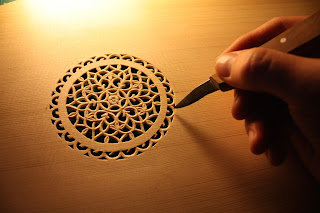Ah, finally, cutting the rose. I've been looking forward to that, having come to woodworking through woodcarving. And it makes a welcomed change from the work on the bowl and the planing of the soundboard.
I chose the Venere rose from the provided designs and got started on the offcut with a narrow gouge that I already owned.
The tool felt a little too wide so I turned to a thinner tool, an ex-acto scalpel which I reground into a chisel shape.
My fingers felt sore pretty soon so I added a wooden grip to help push it down into the wood.
The paper with the pattern is then removed.
Enough practicing, let's move to the real one. To prevent staining the soundboard with my filthy paws and sweat, I covered it with some paper and to avoid having little offcuts creeping between paper and wood, I sealed the whole with tape.
Then, the profile carving.
The last step is the pattern on the circle, for which I prepared a sheet of tracing paper with lines each 3° step to help with regularity. I could then just punch through, diagonally.
Finished !
Read next post : Bracing



















































